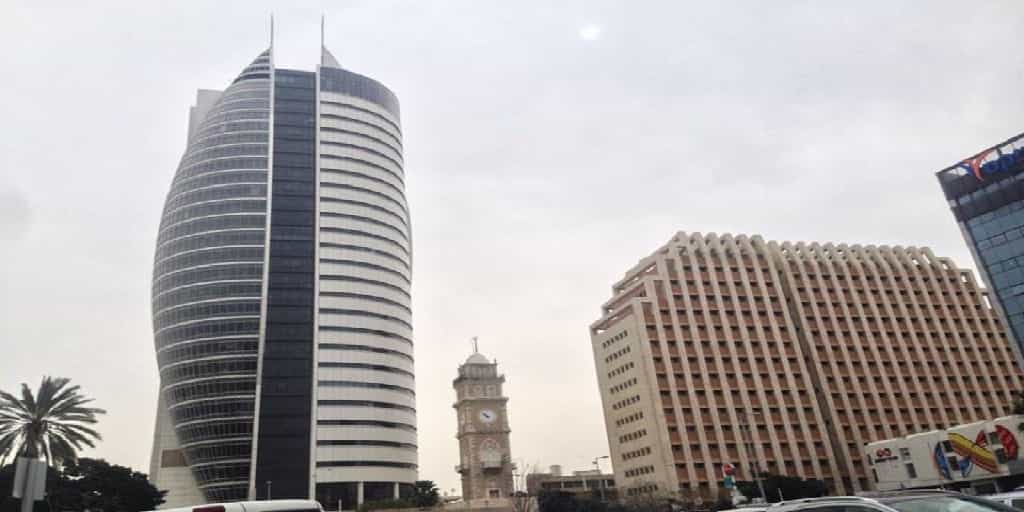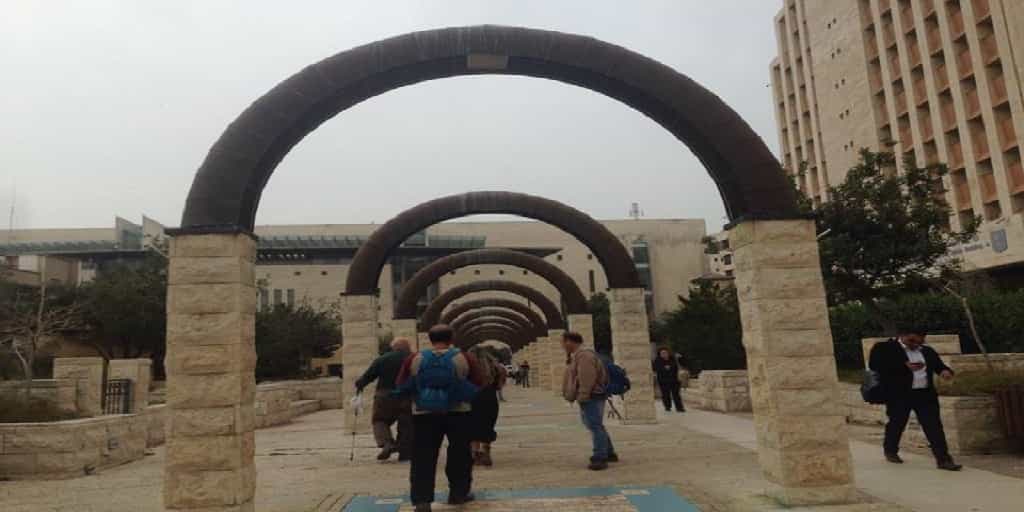Haifa is Israel’s third largest city in the country. It is known for its universities, falafel, and coexistence. It’s a mosaic of different people, religions, and sites. But when many people come to visit, there are very specific sites they visit—the Baha’I gardens, the Stella Maris Convent, the German Colony. We don’t often get to visit the downtown Haifa very often.
So, a group of fellow tour guides and I explored downtown Haifa in order to discover the great stories and corners of this area of the city to show our tourists, friends, and family. What we discovered, what I discovered, pleasantly surprised me. Downtown Haifa is wonderful, and interesting, and charming! I am so glad I went on this trip, so I can in turn show my groups.
What exactly did we do, and where exactly did we go? Well, we met at the center train station in Haifa, and from there we headed to the area of the port of Haifa. The Center train station is named after eight train workers were killed from a rocket falling on the station. The Dagon Silos is built next to the Center train station was built in the 1950’s by Reuben Hecht. It was under the project of David Ben Gurion’s Minister of Treasury Levi Eshkol.
We stopped first at the Port
The port is well- known from the time of the British Mandate. The Crusaders built the port in 1100. But during the Mamluk Period it fell into despair because the Mamluks did not want the Crusaders to come back. It was only deepened by the German Templers from the 1800’s when they establish the German Colony. Theodor Herzl, father of Political Zionism, wanted the port of Haifa to be the major port of Israel, as he wished. However, it was only under the British that it became modernized and important. It was an entry point for many Jewish immigrants during World War II.
Today it is a busy port, with merchant and tourist ships coming in. The bridge on the other side of the station leads to Gate 5, where the cruises for tourists come into the port. It is open 24/7 and one of the busier ports in Israel (along with the ports in Ashdod and Eilat). One might say that Herzl’s dream came true in that respect!
Continuing east, very quickly we entered a neighborhood with an atmosphere that presently surprised me. A few years ago there was a Graffiti Festival, which results have decorated the buildings’ walls. Small artists’ galleries and new restaurants spotted the neighborhood. Every Wednesday, families come to watch movie screenings on the walls of the buildings outside. And there is even a campus of Haifa University smack in the middle! It has such a young and vibrant atmosphere that is easy to enjoy.

There are plans to renovate the port, possibly even making it even into a green port! The idea of having an environmentally sustainable, modern port is very exciting! Israel has a frontier in leading the sustainability world.
From the port we headed toward the Municipality Building…
Where ever you go in Haifa, you can almost always see the municipality building! And the area of the municipality building is the very image of Haifa. The municipality building itself is a very modern building, that looks like a rocket—which is why it is so easy to find when looking around. But right next to it is an Ottoman built mosque, which was the major mosque of Haifa until 1967! Within one picture frame you can fit a modern building alongside a 500- year- old building! Leaving the municipality building are drawings on the tile floors showing Haifa’s history.

I think often times the municipality building and its surroundings should represent the city. And that is the case in Haifa—the modern building with the older history!
We continued along our way in downtown Haifa through Wadi Sabil
This small neighborhood is an essential part of understanding the city. Wadi Sabil means the “Valley of the Heart” in Arabic, and it was the first neighborhood built outside of the Old City walls of Haifa. Until the 1700’s and 1800’s many of the cities in Israel had walls surrounding them. Suleiman Pasha Hallil was the governor at the time, and he was the first to move out of the city walls. He didn’t only build his home, but a bakery, etc. He did this to show that modernity and advancement could only happen when you live the walled city.
During the British Period, the British built a military base next to the neighborhood, creating a lot of tension between the British and the Arab residents living in the neighborhood. In the 1950’s and 1960’s, Wadi Sabil was a poorer neighborhood in Haifa, with many Middle Eastern Jewish residents living here. On July 8, 1959, a police officer shot and wounded a Middle Eastern Jewish resident after a brawl in a bar. The next day hundreds of residents protested in the first of a series of demonstrations against the government around the country. It awakened public awareness of the economic distress Jewish immigrants from the Middle East faced.
What we see here is the beginning of a really important aspect of a democracy—protests, demonstrations, and voicing the needs and opinions of the people of the city. That aspect is part of Israeli democracy until today, from Jerusalem to Tel Aviv to Haifa!!
Along the way, we stopped by a few of the churches in downtown Haifa, as many in the Arab population of this part of Haifa are Christian. Many of the churches commemorate the prophet Eliyahu from the Old Testament, who is believed to be stationed in Haifa.
Before our last stop we walked through the neighborhood of Wadi Nisnas
When many think of Haifa, they think of real, authentic falafel—and this is where you can find it! Wadi Nisnas means “Valley of the Mongoose” in Arabic. Today there are roughly 8,000 residents living in the neighborhood, many of whom are Arab Christians. As we were walking around, we were able to get a feel of everyday life for those living in Haifa. We also got a feel (and a taste, smell, and look) of how diverse Israel really is!

The neighborhood also borders along part of the Baha’I Gardens of Haifa. The Baha’I faith began in modern day Iran but has many holy sites in Israel because their leader, the Baha U’Allah, lived his last years here. The gardens in Haifa are one of those sites, and as a result there are a few homes that the believers working in Haifa rent, live in, and use in Wadi Nisnas while living in downtown Haifa.
We finished our day at the German Colony
The residents of the German Colony make up a unique chapter in the history of Israel. In the 1800’s a group of Germans came to Israel, and began working the land, with the goal of bringing the Second Coming of Jesus faster. They lived in several cities and areas, such as Tel Aviv, Jerusalem, the Galilee, and of course…Haifa! They widened roads, they deepened ports (the same port we started at in the beginning of the day), the advanced agriculture, and they built German homes in their neighborhoods.
That led to the clear visual distinctions when you see when you cross over the invisible border from Wadi Nisnas to the Germany Colony. The homes and buildings are totally different architecturally. And it is really intriguing to explore the differences, and how people choose to build, designs, and decorate their homes.
The story of the German Colonies closed with the beginning of World War II and the tensions between the Germans and the British, who controlled the land at the time. During the early years of Israel, the German Colony was neglected and run down. But in the 1980’s and 1990’s, the municipality renovated the neighborhood and built restaurants, stores, and community centers. Today it is a charming center in Haifa, and it was a great way to end our day in downtown Haifa!
And so in conclusion,
When we ended our day in downtown Haifa, I had learned and discovered so much. While I have always known that Haifa was this mosaic of different people and lifestyles, I got to really experience that while downtown. It was a wonderful experience, that I would love to share with others!

So many times when people come to Israel, they don’t often think to come visit Haifa. And when visitors do come to Haifa, they don’t often explore the downtown area. But when you don’t explore the downtown area, you’re really missing out on a cultural, historical area of the city. This area offers so much to see, and I can’t wait to explore it more.


